19th century art is most easily categorised by the era in which it was created, whether this is the beginning of the century under the Prince Regent, later King George IV, known as the regency period from 1795 to 1837, or the latter half under the reign of Queen Victoria.
 Above: a detail from a portrait by George Peter Alexander Healy, 1842
Above: a detail from a portrait by George Peter Alexander Healy, 1842
In terms of portraiture, this is most clearly seen in the fashions of the passing decades, from the softer, neo-classical dresses of regency women, to the more voluminous or austere drapery of the Victorian era. Although these two influential periods are a rather simplistic way of approaching this diverse century in art history, it helps in looking closely at these precise styles so that we may analyse the possible risks when it comes to the conservation of these popular eras.
Above: our conservator cleaning a small military portrait from the late 18th / early 19th century
Like all antique oil paintings, 19th century portraits may deteriorate due to their age, with rusting nails and wooden stretcher bars decaying. They may also discolour due to the historic varnish surface creating a yellow or darkened veil. Such portraits may have frequently been exposed to fireplaces or nicotine, worsening the loss of visual impact as the smoke contamination builds up over decades.
 Above: a regency portrait which was restored by our conservation team, removing the build up of contamination and discoloured varnish
Above: a regency portrait which was restored by our conservation team, removing the build up of contamination and discoloured varnish
There are many more issues which a portrait from this century may have faced, which we will discuss in this article about the history, themes and common conditions found during the conservation of 19th century portraiture.
 Above: our conservator expertly cleaning a portrait of a gentleman in our studio with a tailored solution
Above: our conservator expertly cleaning a portrait of a gentleman in our studio with a tailored solution
Neoclassical and regency portraiture
During the Regency period the style for free flowing light gowns for women and simple tailored suits or Napoleonic war attire for men is a good indicator of age. Much in terms of fashion and interior design was influenced both by the French, particularly neoclassicism, and the expansion of the Empire.
 Above: a selection of regency portraits displaying the fashion of an empire line dress, artists include Merry-Joseph Blondel, Jean-Bernard Duvivier, and Gilbert Stuart
Above: a selection of regency portraits displaying the fashion of an empire line dress, artists include Merry-Joseph Blondel, Jean-Bernard Duvivier, and Gilbert Stuart
It is important to note that following the French revolution of the late 18th century, the grandeur of the baroque and rococo age ceased to be fashionable and instead clothing became an expression of the individual rather than purely social status. Fashion also became far more natural and so aristocratic styles became closer to that of the working class in terms of practicality with skirts and jackets, free of hard boned corsets.
 Above: a detail from a portrait of two aristocratic ladies by George Hayter, 1830
Above: a detail from a portrait of two aristocratic ladies by George Hayter, 1830
The look was in many cases reminiscent of classical robes as traditionally viewed in art, such as historic history paintings and the neoclassical art of the era. Classism was important to high society, who saw themselves as a continuation of idealised ancient civilisations and imperial power. Neoclassical fashion was inspired by many archaeological finds of the era, including the famous Elgin Marbles which still reside in the British Museum.
 Above: in some cases it was the fashion to wear more frilled and modest garments, especially with older generations as seen in this portrait from 1818 by William Owen
Above: in some cases it was the fashion to wear more frilled and modest garments, especially with older generations as seen in this portrait from 1818 by William Owen
Men’s fashion followed the same ideals with extravagant details and embellishment banished in exchange for simple tailoring. This allowed for the natural form of the body to be displayed freely, most notably seen on “dandy” portraits of the era – young men who prided themselves on refined and elegant fashion. You may also find many military portraits with reference to the Napoleonic War.
 Above: a print of a regency ballroom scene, displaying many fashions you might encounter in this period
Above: a print of a regency ballroom scene, displaying many fashions you might encounter in this period
Regency portrait restoration
Many portraits from the Regency period have been restored by our team at Fine Art Restoration Company. As it was fashionable for women to wear white, it is often very noticeable for such portraits to discolour or yellow, vastly decreasing the original bright tones which are central to the style.
 Above: a discoloured regency portrait which was restored by our team, here it is seen before and after varnish removal and surface cleaning – the heavy cracking was consolidated and stabilised to reduce any risk of it growing worse and flaking away from the canvas
Above: a discoloured regency portrait which was restored by our team, here it is seen before and after varnish removal and surface cleaning – the heavy cracking was consolidated and stabilised to reduce any risk of it growing worse and flaking away from the canvas
Our conservators first assess the portrait and then perform a surface clean and varnish removal, this will eradicate any visual disturbances caused by the darkening varnish layer. Varnish can become yellow due to its natural properties, historically this material was made from tree resin which decays and perishes over time. This layer can be replaced with a new conservation grade variety which is non-yellowing and UV protective. Varnish can also become discoloured by nicotine and fireplaces, as we will mention in our section about Victorian portrait restoration below.
Above: signs of unoriginal paint on a Napoleonic war memorial portrait – sometimes a painting will have over-painting which has been added at a later date to edit the artwork or to cover up an old repair, our team will search for this and can reverse this if required
Above: sometimes the varnish and contamination is so thick that is requires a specialist gel removal, as seen in this heavily discoloured family portrait which was cleaned by our conservator
Above: our conservator gently retouching tiny areas of a small regency portrait, this reduces visual disturbances and further stabilises the painting
Torn paintings and artworks with flaking paint layers, warping, or further surface damage, can also be restored by our team who are able to offer a wider range of conservation treatments to bring the portrait back to full health before it is returned to display.
 Above: a 19th century portrait of a young man which was restored in our studio, seen here before, during, and after varnish removal
Above: a 19th century portrait of a young man which was restored in our studio, seen here before, during, and after varnish removal
Frames from this era may have become brittle and unstable over time, this can be caused by a frequently changing environment (causing the wood to expand and contract) or due to old age. Our specialist frame conservator can re-stabilise a loose frame and clear away any build up of contamination.
 Above: an antique frame before and after restoration and gilding by our specialist frame conservator
Above: an antique frame before and after restoration and gilding by our specialist frame conservator
If a frame has broken pieces these can also be re-adhered professionally or recreated if lost, as well as being gilded with traditional techniques. Where a painting requires a new frame, our team can also provide era-appropriate options.
Famous 19th century portrait artists
Influential portrait artists from the Regency and Victorian periods include:
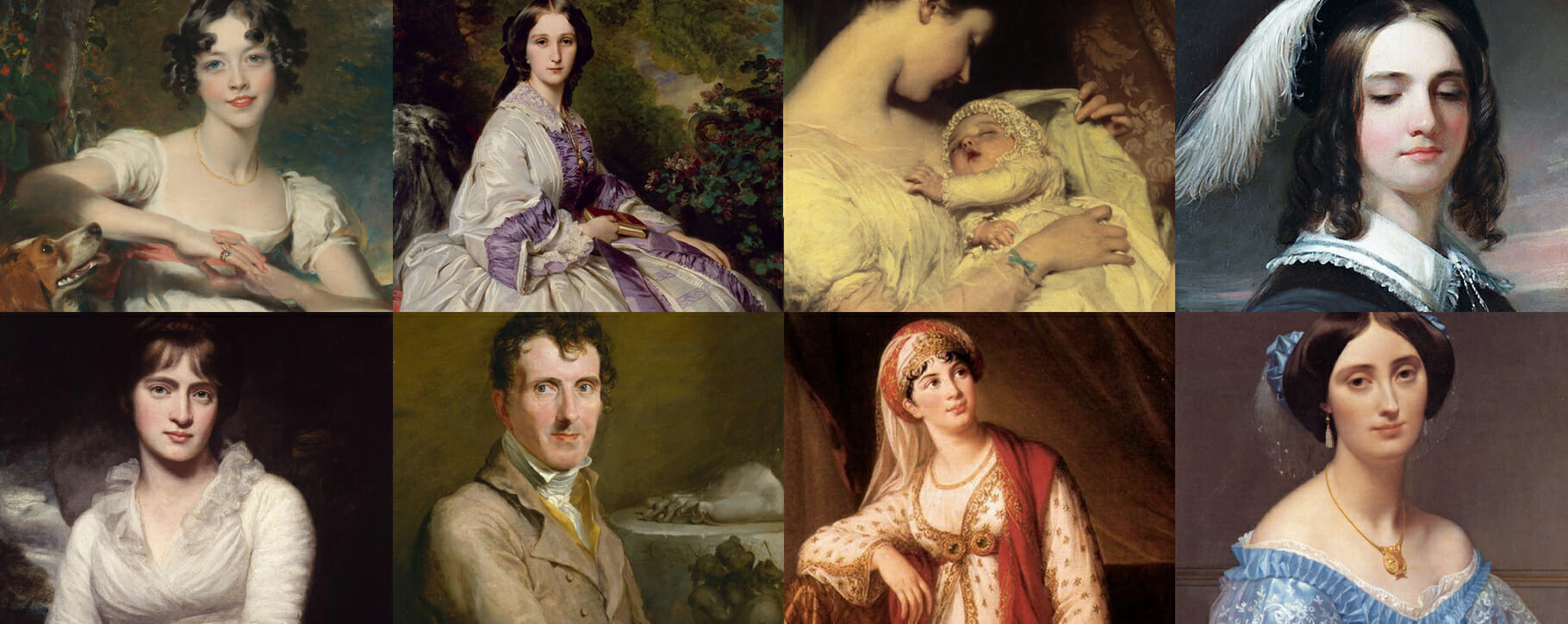
Thomas Lawrence 1769-1830 (top left), John Opie 1761-1807 (bottom left), Franz Xaver Winterhalter 1805-1873 (top centre left), George Hayter 1792-1871 (bottom centre left), James Sant 1820-1916 (top centre right), Élisabeth Louise Vigée Le Brun 1755-1842 (bottom centre right), Daniel Huntington 1801-1846 (top right), and Jean Auguste Dominique Ingres 1780-1867 (bottom right)
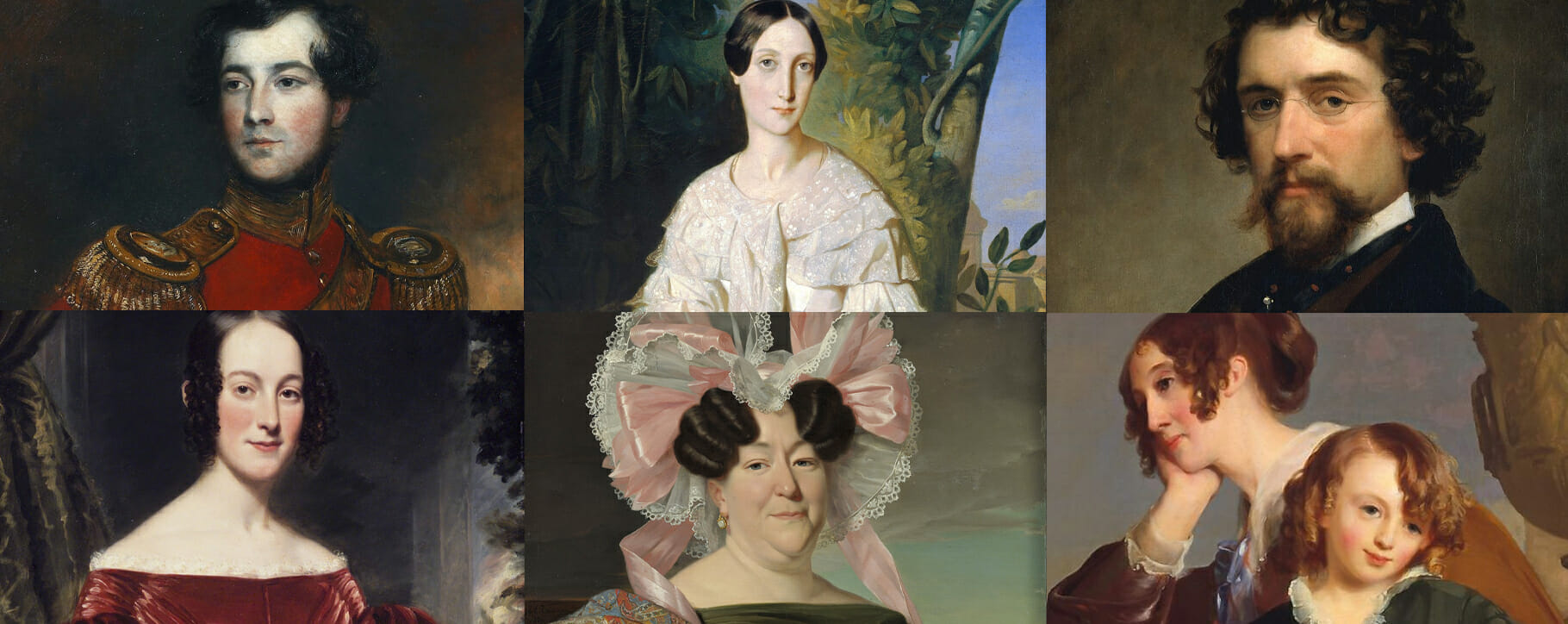
Frederick Yeates Hurlstone 1800-1869 (top left), Henry Inman 1801-1846 (bottom left), Théodore Chassériau 1819-1856 (top centre), Jan Adam Kruseman 1804-1862 (bottom centre), Charles Loring Elliott 1812-1868 (top right), and Thomas Sully 1783-1872 (bottom right)
Styles in Victorian portraiture
In the Victorian era the ideas of Empire continued, but the natural themes of neoclassicism were abandoned for a return to some level of extravagance, bell shaped skirts for women with a crinoline cage are one of the most noticeable changes as their shape developed over the era, as well as lace, floral designs and the beginnings of mass production.
 Above: a selection of Victorian portraits displaying the fashions of the era, artists include Francis Grant, Aloizy Reichan and R. T. Bott
Above: a selection of Victorian portraits displaying the fashions of the era, artists include Francis Grant, Aloizy Reichan and R. T. Bott
It is a common misconception that all Victorian styles were preoccupied with modesty, as many aspects such as a tight corset, exaggerated hips and low necklines display sexuality. This can often be seen in portraits of ladies in their ball gowns or best formal dresses. Women’s hair is often in ringlets on either side of the head, or similarly curled, as was the signature style of a young Queen Victoria.
 Above: a detail from a portrait of a girl by Samuel F. B. Morse, here you can see the display of bare shoulders in 1830s fashion
Above: a detail from a portrait of a girl by Samuel F. B. Morse, here you can see the display of bare shoulders in 1830s fashion
Men’s fashion saw three-piece suits grow in popularity and there was still a tight fitted aesthetic with a focus on good tailoring from reputable establishments. There was also a revival in the fashion of facial hair, with beards, moustaches and sideburns becoming more popular.
 Above: an example of men’s fashion in the Victorian era, a detail from a Portrait of George Jacob Holyoake by William Holyoake
Above: an example of men’s fashion in the Victorian era, a detail from a Portrait of George Jacob Holyoake by William Holyoake
Family portraits were popular throughout the 19th century but it was Queen Victoria’s large family with Prince Albert that inspired a great deal of artwork with themes of family care devotion with children at play and close to their parents with a natural theme. As technology such as photography was beginning to be developed, it was the traditional artist’s job to give the patron more than just a simple replica of reality, and so charming interior scenes were a popular choice in capturing an ideal life on canvas.
 Above: a detail which displays family devotion from A Portrait of Reverend Zachariah Greene by William Sidney Mount, 1852
Above: a detail which displays family devotion from A Portrait of Reverend Zachariah Greene by William Sidney Mount, 1852
Victorian portrait restoration
Many Victorian portraits which come to our team at Fine Art Restoration Company have been affected by lifelong exposure to fireplaces and nicotine. This often shows up as a very dark surface layer, where the varnish has become extremely yellow or dark due to this airborne contamination. Even if the painting has not recently been in close contact with smoking rooms or fireplaces, it is highly likely that it would have been around them over the course of its life.
Above: our conservator performing a varnish removal a Victorian portrait in our Carlisle studio
Smoke and nicotine contamination cannot be removed with home cleaning techniques and this should not be attempted for fear of damage by over-cleaning the surface with inappropriate chemicals or techniques. Professional conservators must instead perform a varnish removal with their carefully selected solvents which are tested to the materials of the artwork. This sort of visual disturbance can lead to the acidic elements of the smoke penetrating through to the paint layer or canvas and developing a brittle and weakening painting over time – it is important for the overall health of the portrait to have discolouration removed.
 Above: a Victorian portrait restored by our easel painting conservators, before and after conservation treatments to remove surface contamination
Above: a Victorian portrait restored by our easel painting conservators, before and after conservation treatments to remove surface contamination
Paintings may have also become lighter, with a thin white veil caused by moisture damage or mould. This can also be removed by our team, who will also put the artwork into o-zone treatment to kill any dangerous spores.
Above: our conservator clearing discoloured and blanched varnish away from a Victorian portrait in our London studio
Tears, failing historic repairs, and warping, are further reasons we see many Victorian portraits in our studio. All of these issues can be resolved with carefully considered treatments which suit the needs of each individual painting.
 Above: this important family heirloom was cleaned in our London studio, a note was found on the back which was written by the sitter’s husband – this was preserved alongside the rest of the artwork
Above: this important family heirloom was cleaned in our London studio, a note was found on the back which was written by the sitter’s husband – this was preserved alongside the rest of the artwork
Tears can be restored with thread-by-thread techniques and gently retouched with seamless conservation grade pigments. Old repairs or areas of historic over-painting can also be removed and replaced with safer contemporary treatments. Warping, bends and dents to the canvas can be restored with professional flattening of the painting with techniques which ensure it is stable before returning to display.
 Above: a torn Victorian portrait which was expertly restored by our conservation team
Above: a torn Victorian portrait which was expertly restored by our conservation team
Displaying and preserving 19th century portraits
Oil paintings can survive for hundreds of years in the correct conditions, especially once they have been professionally restored by a trained conservator. Once any discolouration or damage has been treated, it is worth considering the correct environment for display.
 Above: a water damaged Victorian portrait before and after restoration by our conservators
Above: a water damaged Victorian portrait before and after restoration by our conservators
It is a museum standard to keep oil paintings between 18 to 24°C and with a relative humidity of 40-50% to avoid the growth of mould and moisture damage. It is important not to have constant fluctuations in environments, as the materials may move depending on this. Do not display a painting near to a heat source (such as a radiator or vent) to avoid this changing atmosphere, as well as areas like windows and doors.
 Above: paintings can discolour due to fireplaces or nicotine, keep artwork away from open fires or places with fumes, smoke or pollution
Above: paintings can discolour due to fireplaces or nicotine, keep artwork away from open fires or places with fumes, smoke or pollution
A well-fitted frame is also important, this will be one that is not too tight (this leads to warping and stress on the canvas) or too loose (this may cause the canvas to move and rub against the edges). Frames can be completely restored by our team or new era-appropriate options can be put together for your artwork and individual style.
 Above: frame details can be restored, such as this crown on an engraving of Queen Victoria and her extended family – completed by our frame conservator
Above: frame details can be restored, such as this crown on an engraving of Queen Victoria and her extended family – completed by our frame conservator
Get in touch with our team
If you have a 19th century portrait, or any other artwork in your care which may require conservation treatment, please do not hesitate to get in touch with our helpful team.
To make contact please email us via [email protected] or call 0207 112 7576.
You may also be interested in:

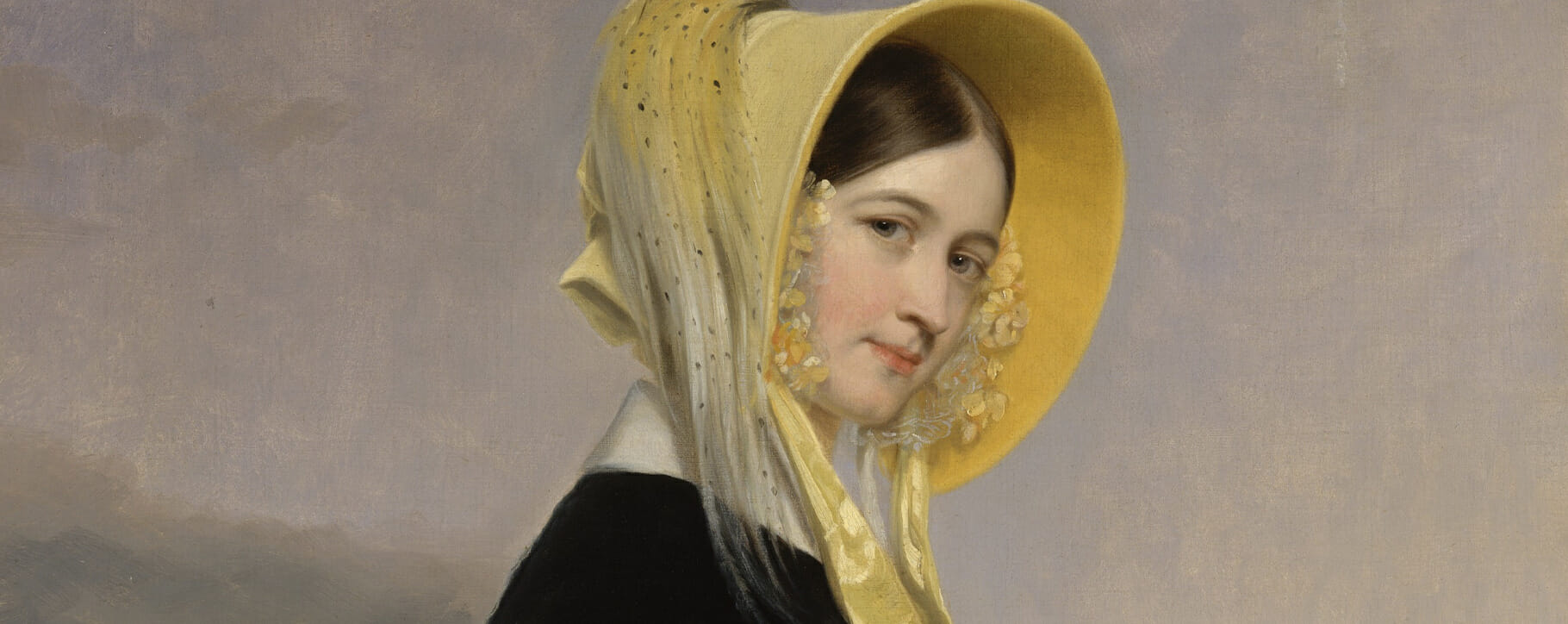 Above: a detail from a portrait by George Peter Alexander Healy, 1842
Above: a detail from a portrait by George Peter Alexander Healy, 1842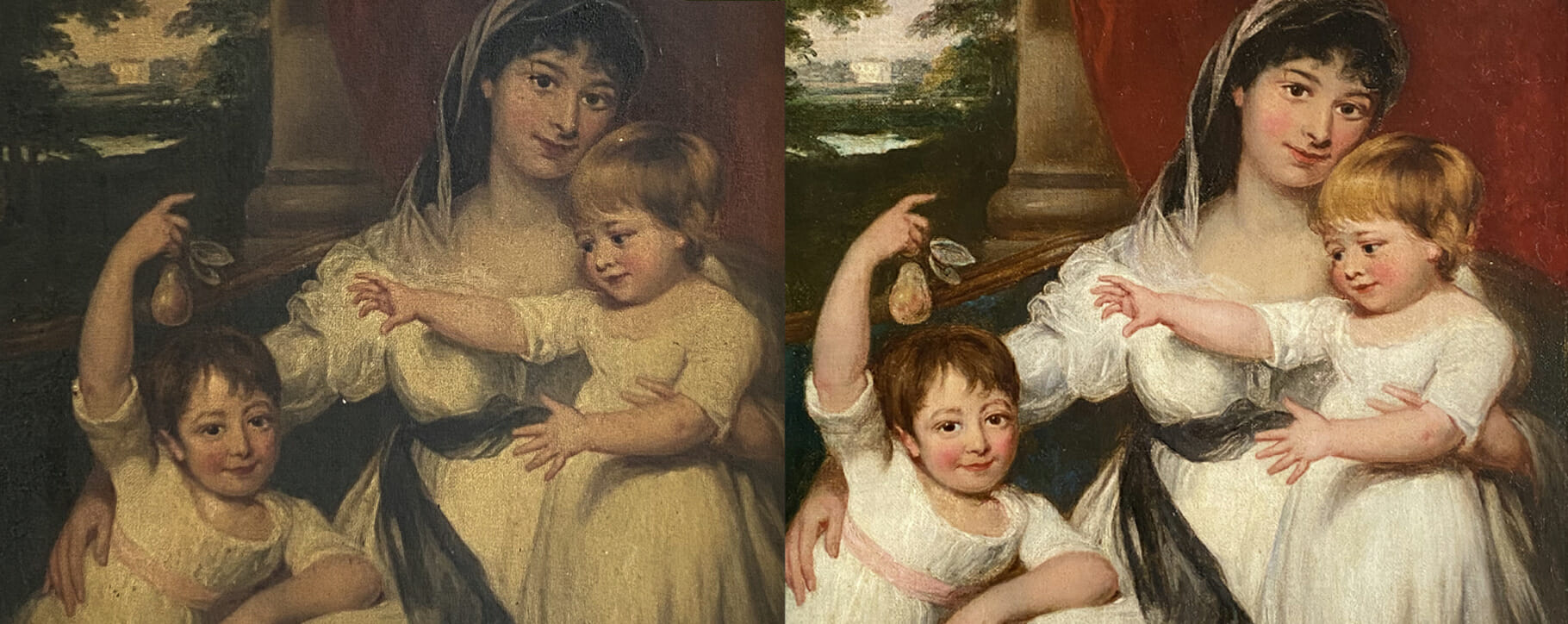 Above: a regency portrait which was restored by our conservation team, removing the build up of contamination and discoloured varnish
Above: a regency portrait which was restored by our conservation team, removing the build up of contamination and discoloured varnish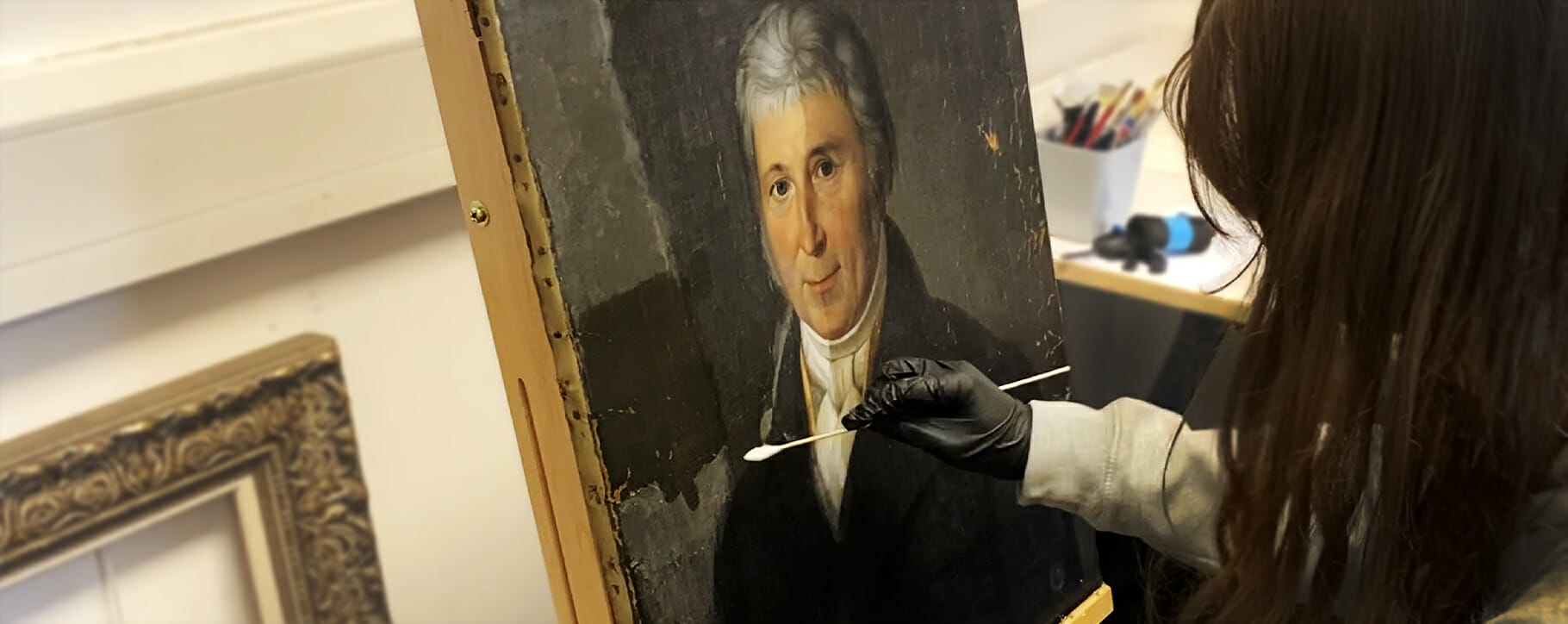 Above: our conservator expertly cleaning a portrait of a gentleman in our studio with a tailored solution
Above: our conservator expertly cleaning a portrait of a gentleman in our studio with a tailored solution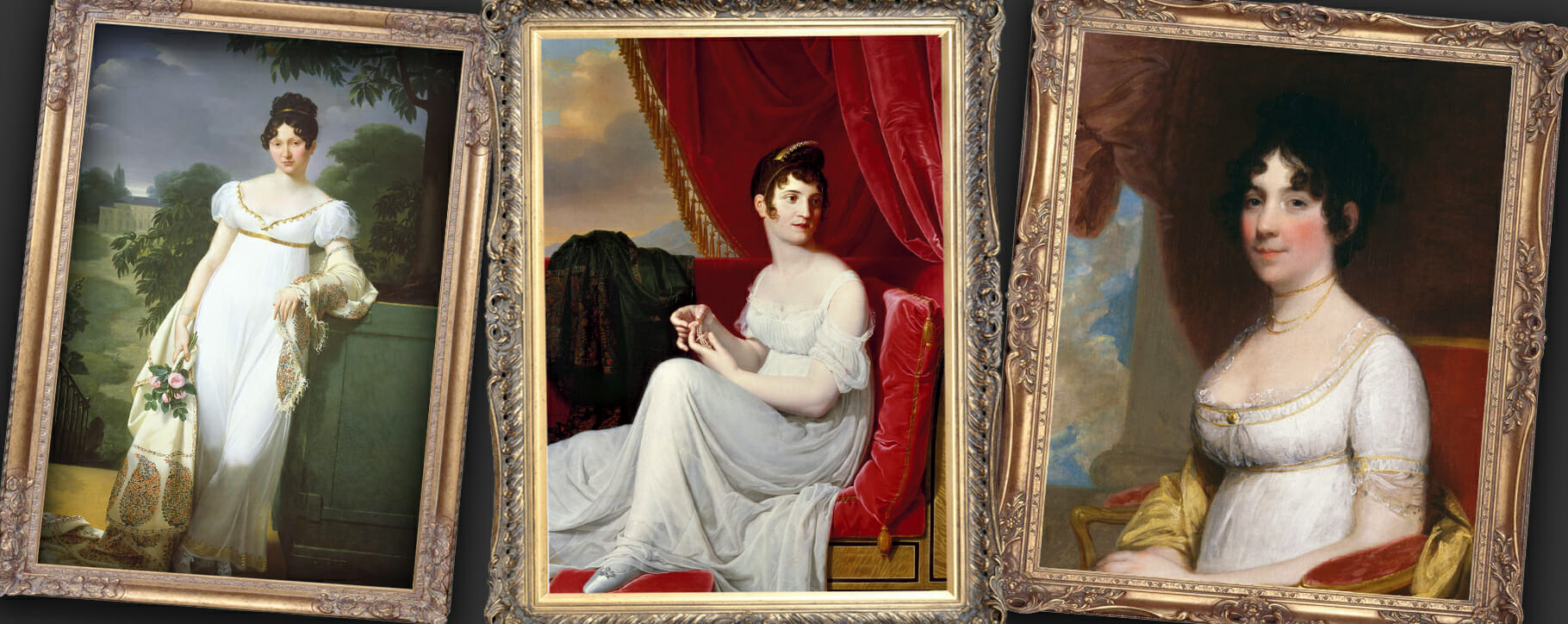 Above: a selection of regency portraits displaying the fashion of an empire line dress, artists include Merry-Joseph Blondel, Jean-Bernard Duvivier, and Gilbert Stuart
Above: a selection of regency portraits displaying the fashion of an empire line dress, artists include Merry-Joseph Blondel, Jean-Bernard Duvivier, and Gilbert Stuart Above: a detail from a portrait of two aristocratic ladies by George Hayter, 1830
Above: a detail from a portrait of two aristocratic ladies by George Hayter, 1830 Above: in some cases it was the fashion to wear more frilled and modest garments, especially with older generations as seen in this portrait from 1818 by William Owen
Above: in some cases it was the fashion to wear more frilled and modest garments, especially with older generations as seen in this portrait from 1818 by William Owen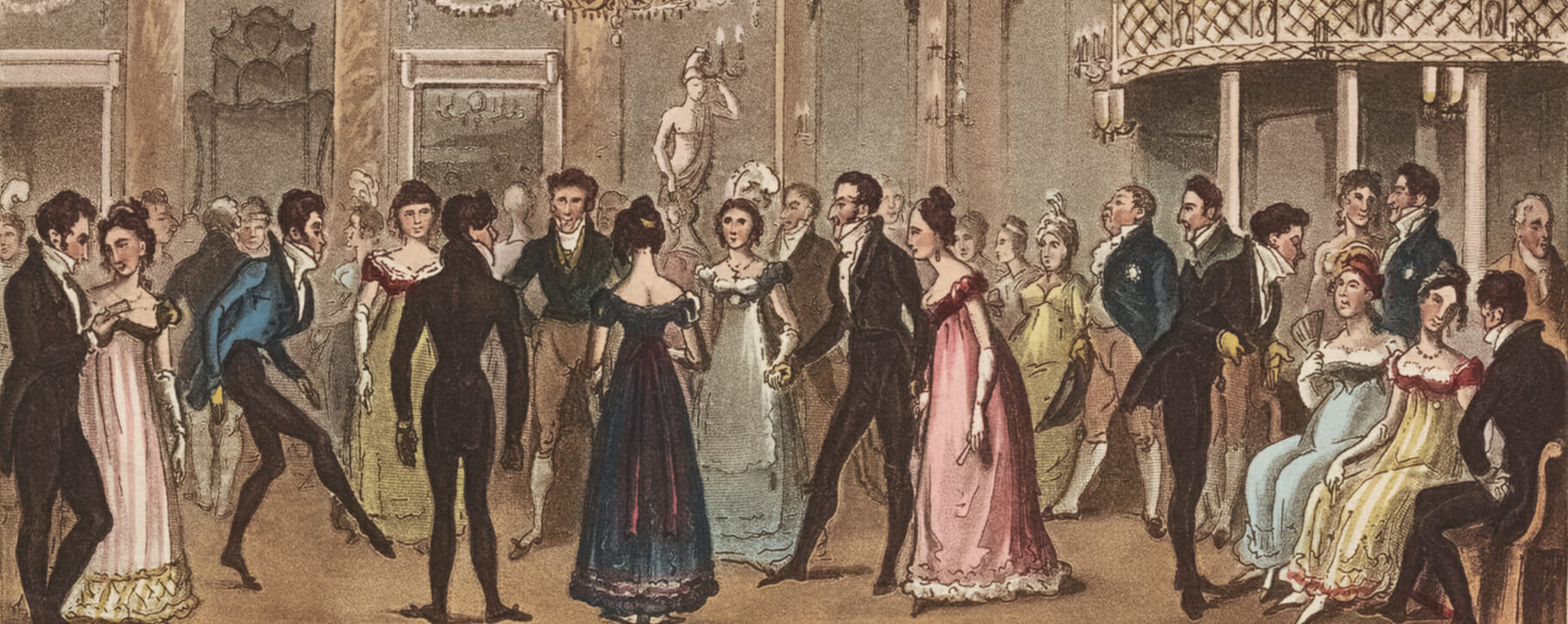 Above: a print of a regency ballroom scene, displaying many fashions you might encounter in this period
Above: a print of a regency ballroom scene, displaying many fashions you might encounter in this period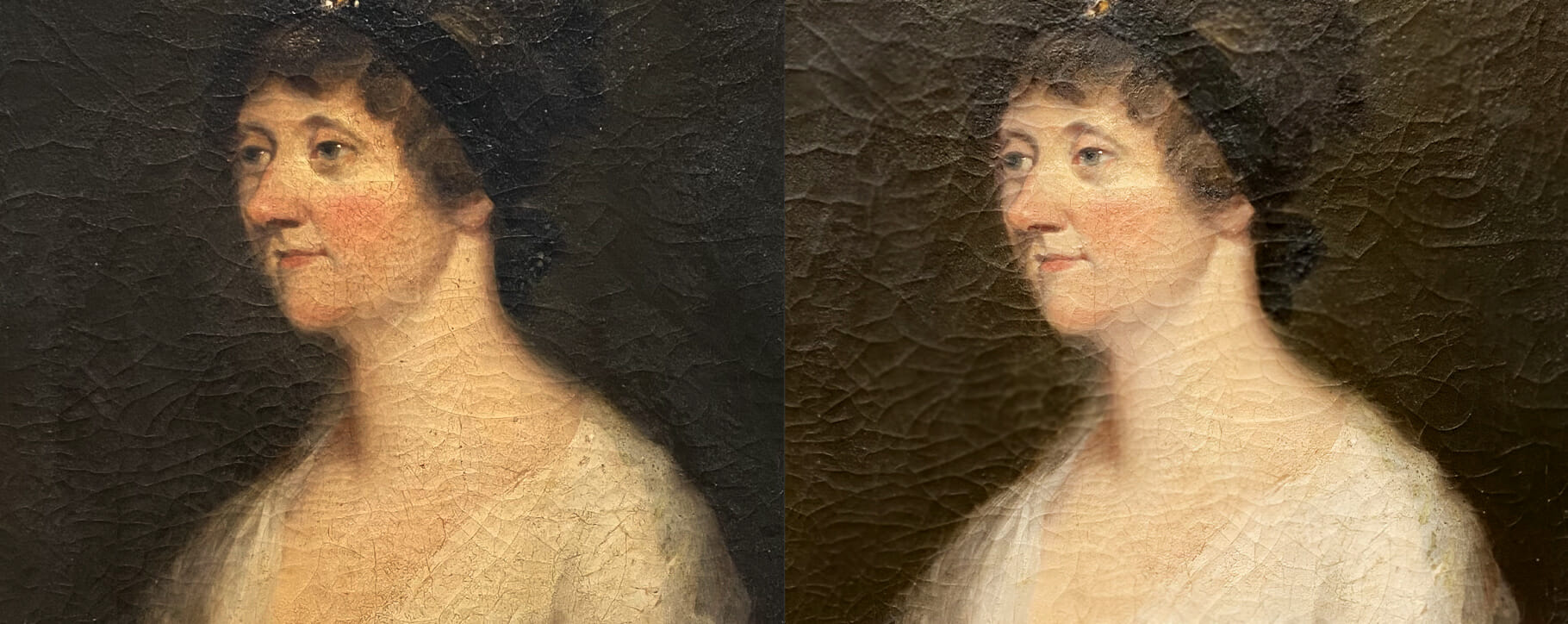 Above: a discoloured regency portrait which was restored by our team, here it is seen before and after varnish removal and surface cleaning – the heavy cracking was consolidated and stabilised to reduce any risk of it growing worse and flaking away from the canvas
Above: a discoloured regency portrait which was restored by our team, here it is seen before and after varnish removal and surface cleaning – the heavy cracking was consolidated and stabilised to reduce any risk of it growing worse and flaking away from the canvas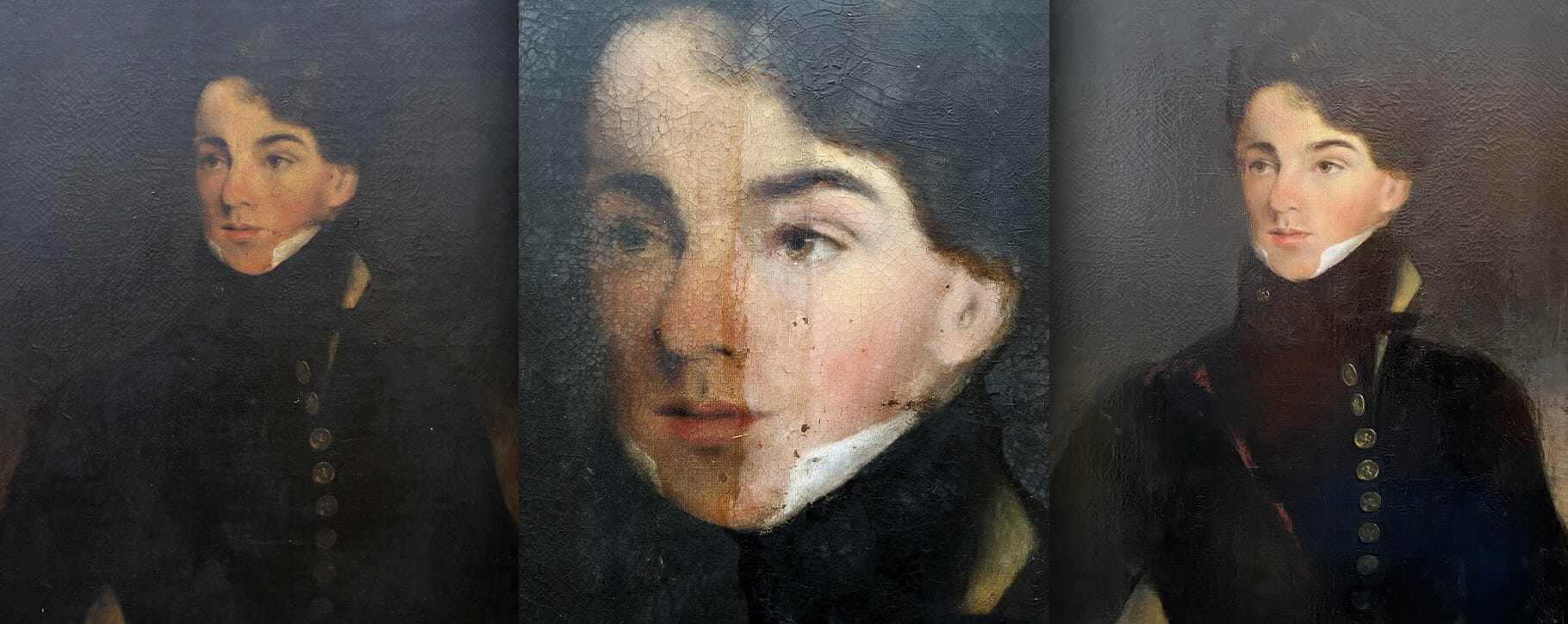 Above: a 19th century portrait of a young man which was restored in our studio, seen here before, during, and after varnish removal
Above: a 19th century portrait of a young man which was restored in our studio, seen here before, during, and after varnish removal Above: an antique frame before and after restoration and gilding by our specialist frame conservator
Above: an antique frame before and after restoration and gilding by our specialist frame conservator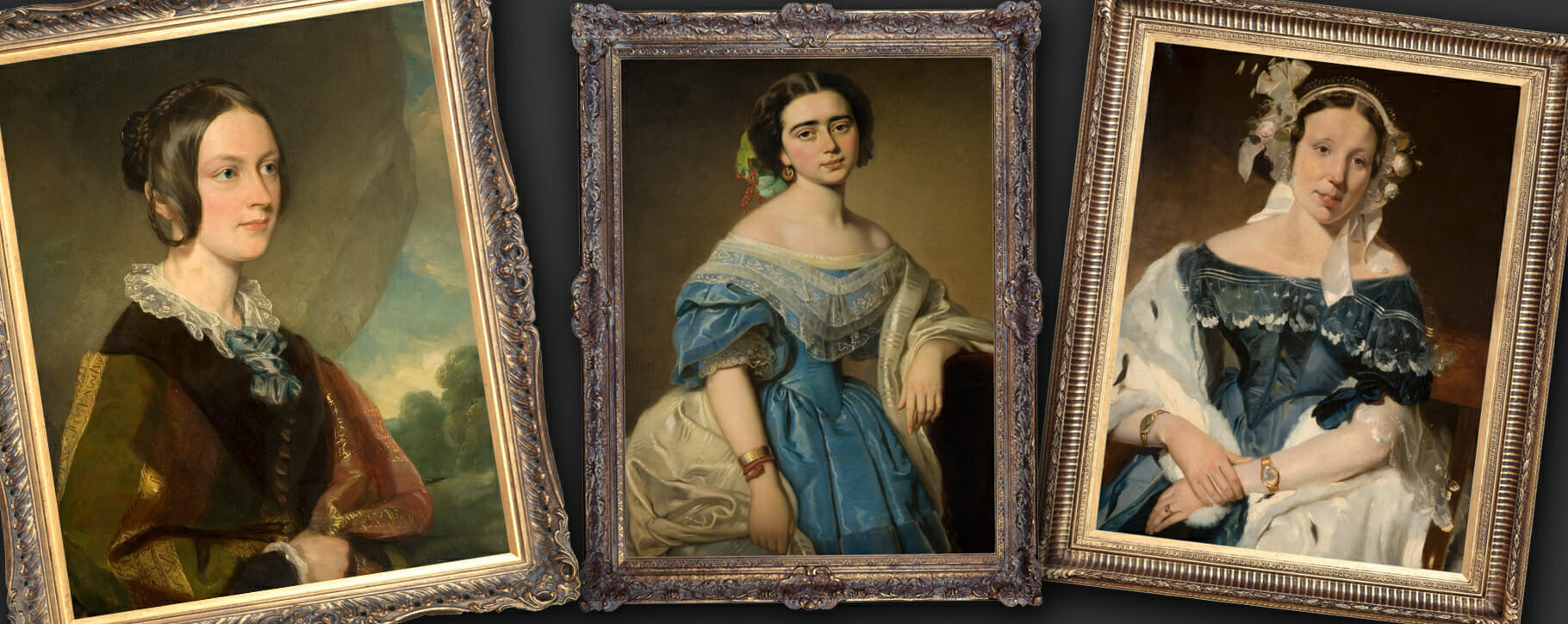 Above: a selection of Victorian portraits displaying the fashions of the era, artists include Francis Grant, Aloizy Reichan and R. T. Bott
Above: a selection of Victorian portraits displaying the fashions of the era, artists include Francis Grant, Aloizy Reichan and R. T. Bott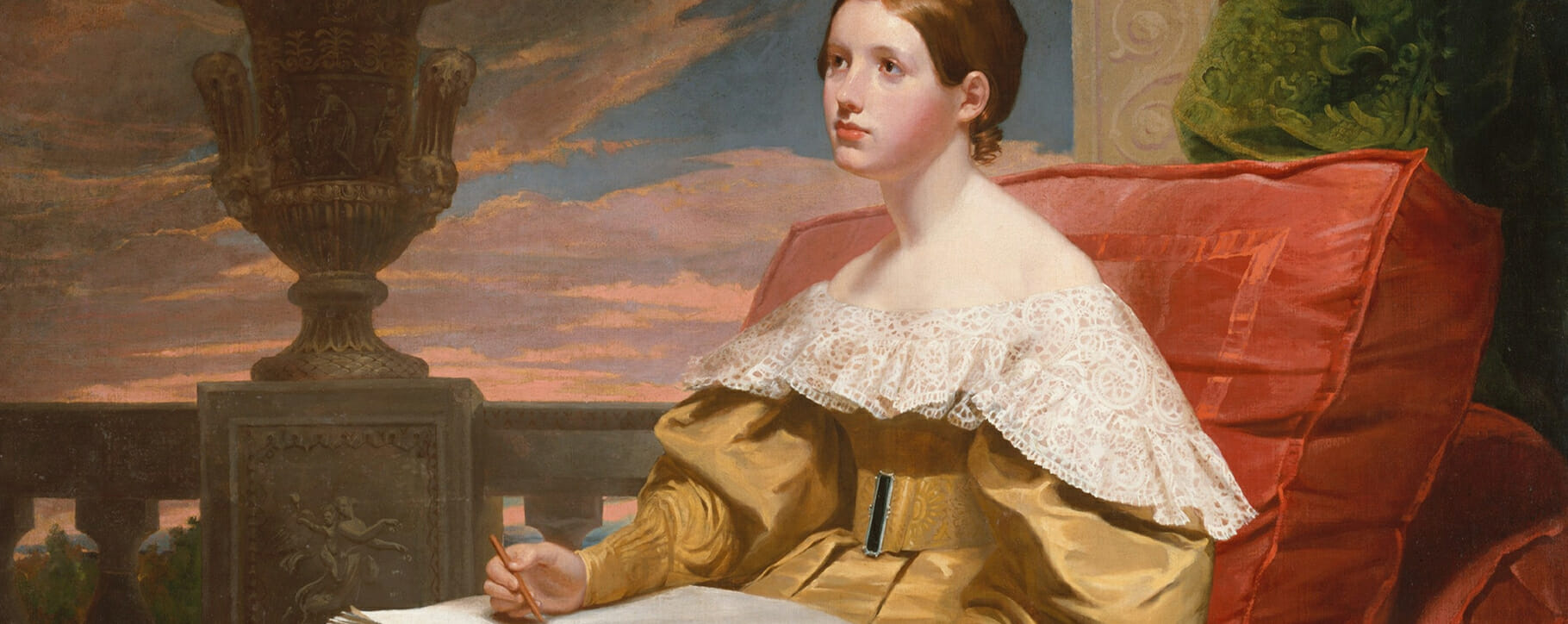 Above: a detail from a portrait of a girl by Samuel F. B. Morse, here you can see the display of bare shoulders in 1830s fashion
Above: a detail from a portrait of a girl by Samuel F. B. Morse, here you can see the display of bare shoulders in 1830s fashion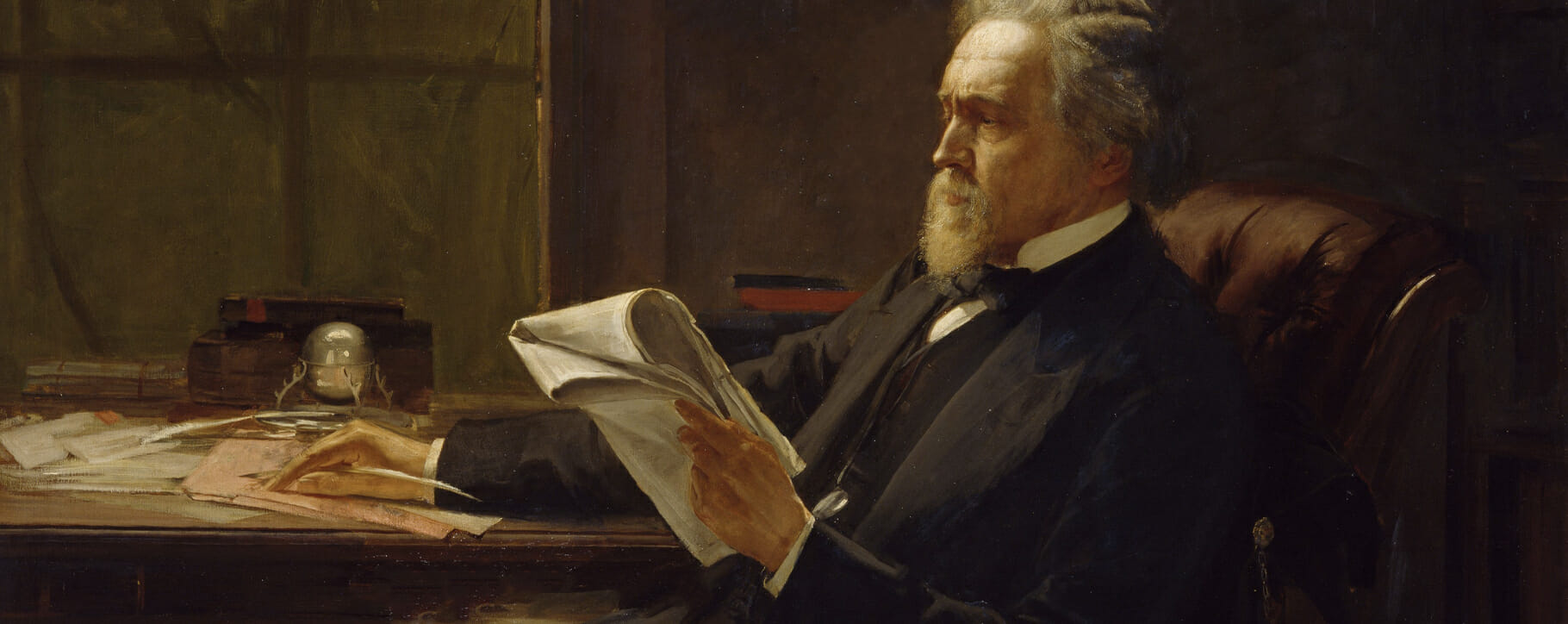 Above: an example of men’s fashion in the Victorian era, a detail from a Portrait of George Jacob Holyoake by William Holyoake
Above: an example of men’s fashion in the Victorian era, a detail from a Portrait of George Jacob Holyoake by William Holyoake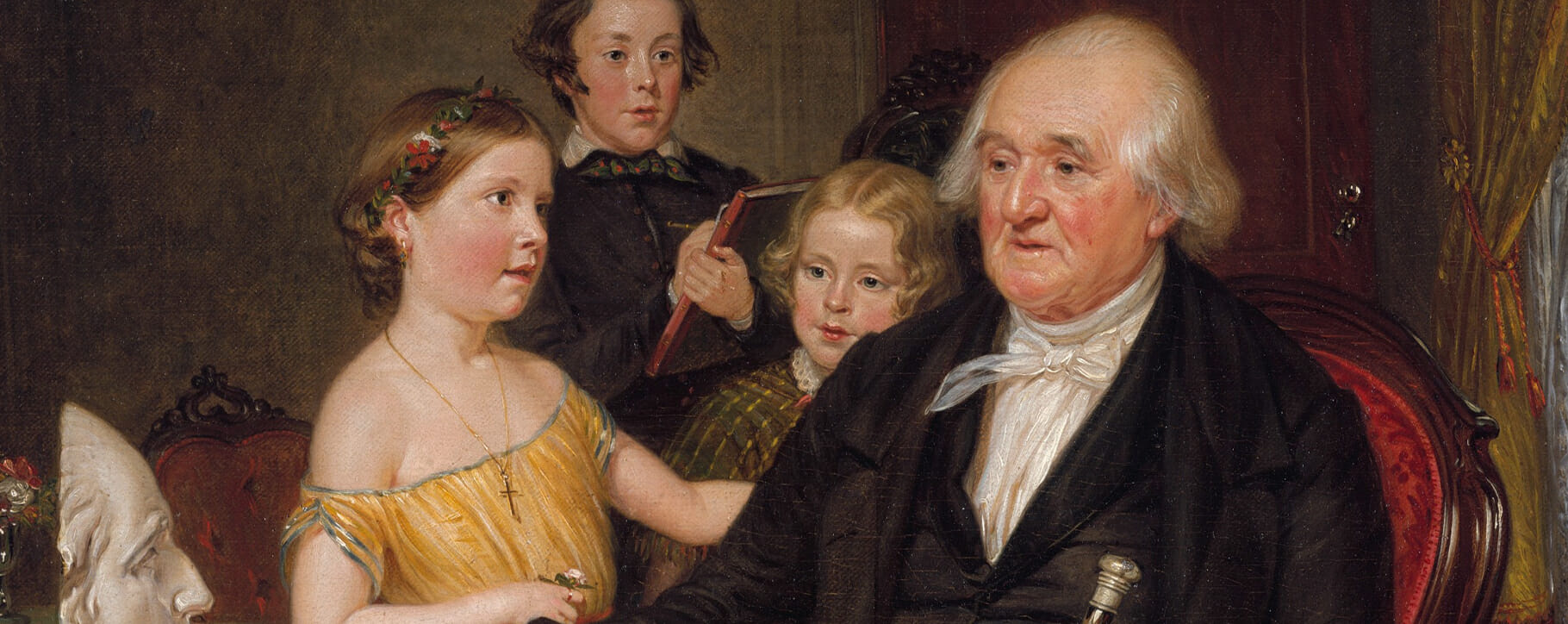 Above: a detail which displays family devotion from A Portrait of Reverend Zachariah Greene by William Sidney Mount, 1852
Above: a detail which displays family devotion from A Portrait of Reverend Zachariah Greene by William Sidney Mount, 1852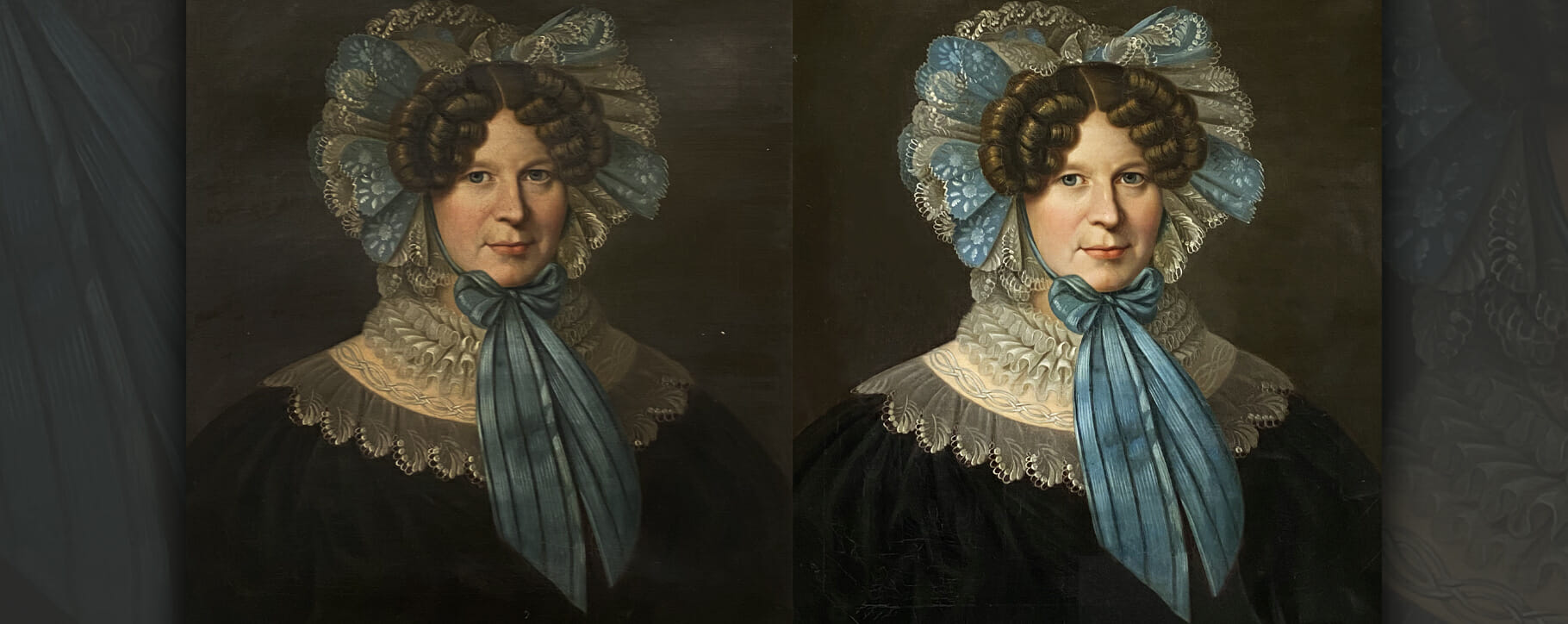 Above: a Victorian portrait restored by our easel painting conservators, before and after conservation treatments to remove surface contamination
Above: a Victorian portrait restored by our easel painting conservators, before and after conservation treatments to remove surface contamination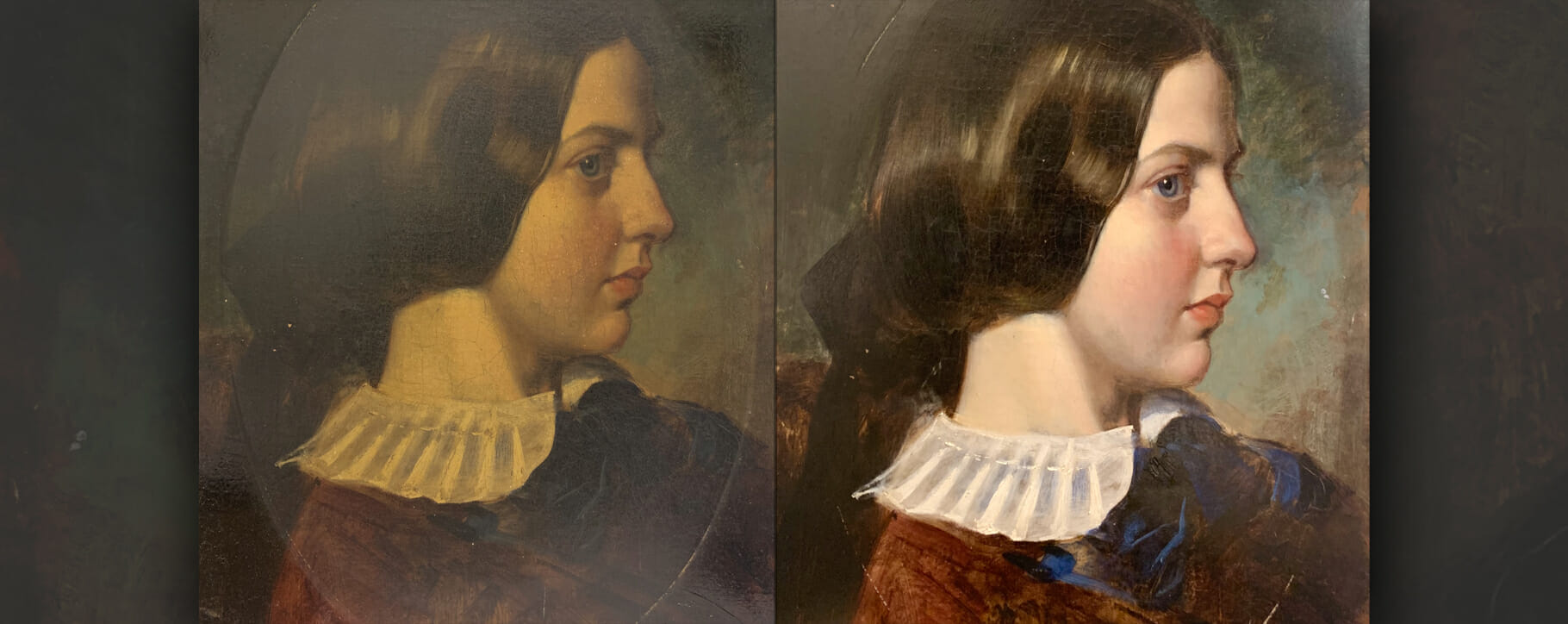 Above: this important family heirloom was cleaned in our London studio, a note was found on the back which was written by the sitter’s husband – this was preserved alongside the rest of the artwork
Above: this important family heirloom was cleaned in our London studio, a note was found on the back which was written by the sitter’s husband – this was preserved alongside the rest of the artwork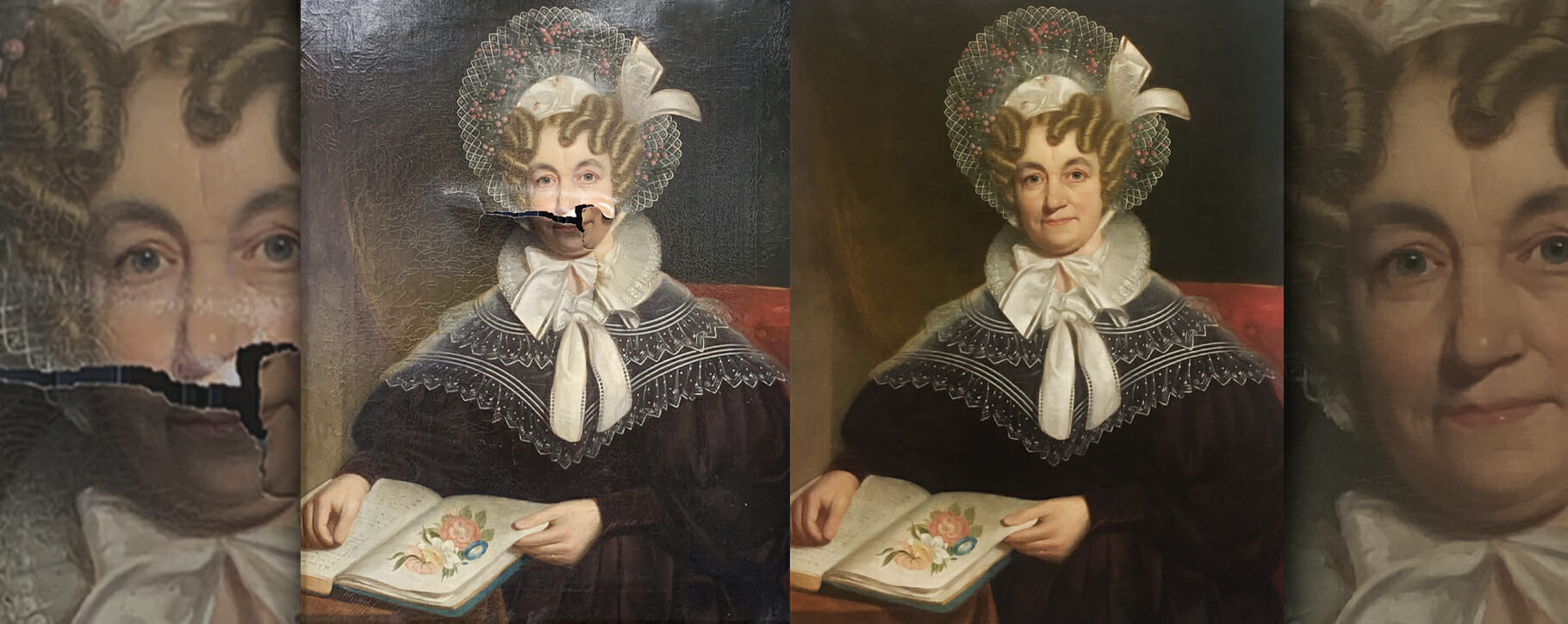 Above: a torn Victorian portrait which was expertly restored by our conservation team
Above: a torn Victorian portrait which was expertly restored by our conservation team Above: a water damaged Victorian portrait before and after restoration by our conservators
Above: a water damaged Victorian portrait before and after restoration by our conservators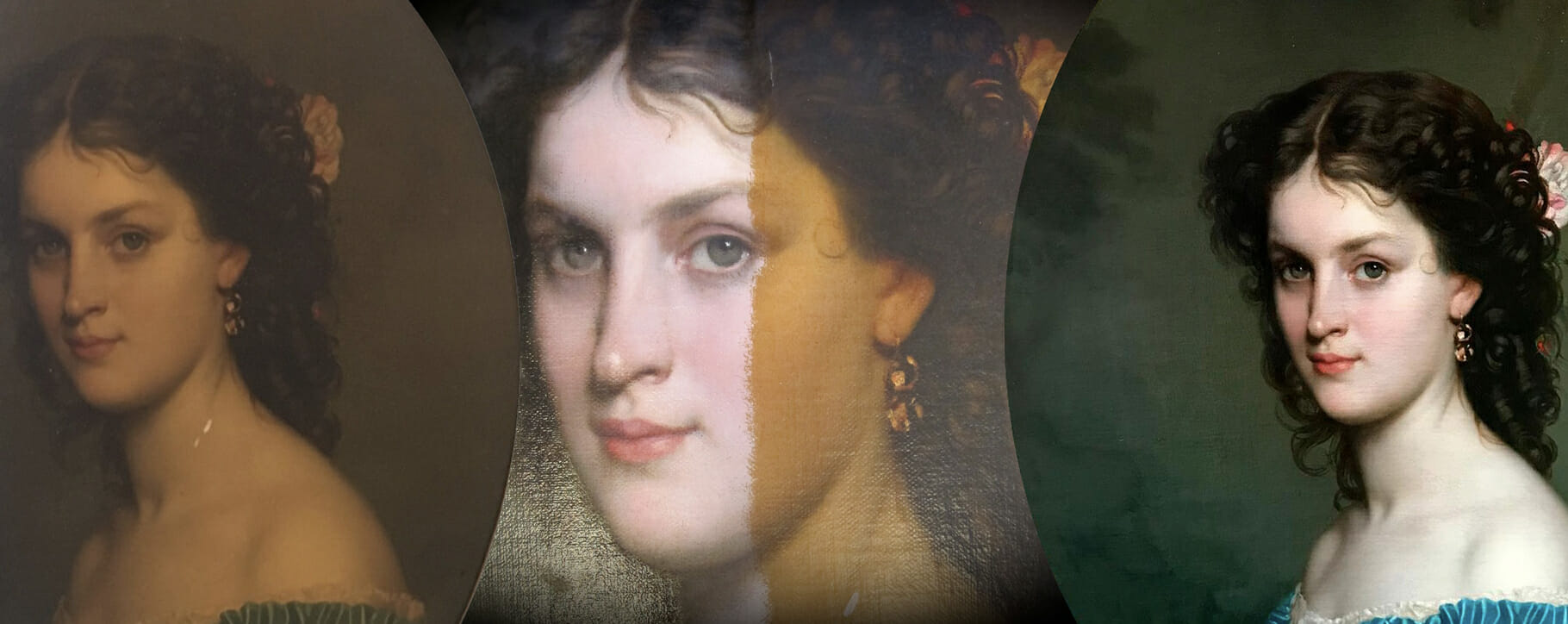 Above: paintings can discolour due to fireplaces or nicotine, keep artwork away from open fires or places with fumes, smoke or pollution
Above: paintings can discolour due to fireplaces or nicotine, keep artwork away from open fires or places with fumes, smoke or pollution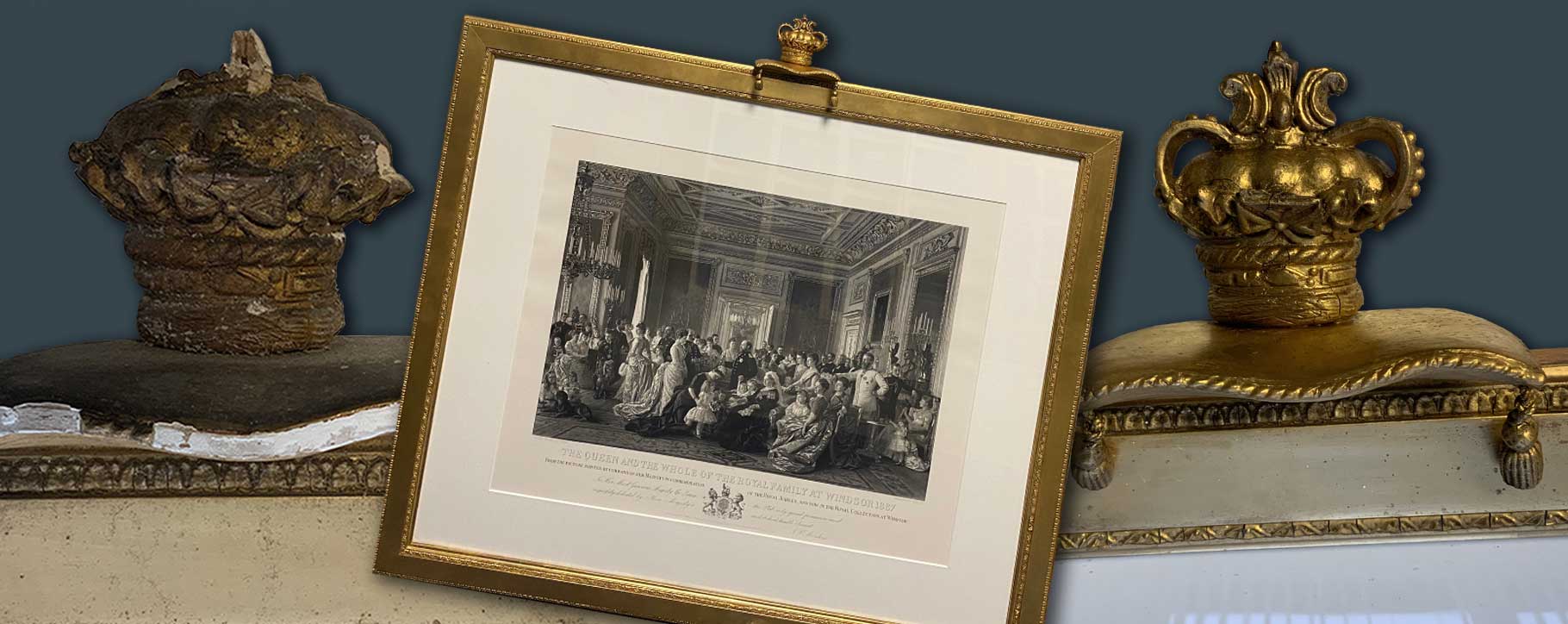 Above: frame details can be restored, such as this crown on an engraving of Queen Victoria and her extended family – completed by our frame conservator
Above: frame details can be restored, such as this crown on an engraving of Queen Victoria and her extended family – completed by our frame conservator




